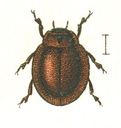Plant-eating Lady Beetles
Epilachninae
Classification
- Phylum: Arthropoda
- Subphylum: Hexapoda
- Class: Insecta
- Order: Coleoptera
- Suborder: Polyphaga
- Superfamily: Coccinelloidea
- Family: Coccinellidae
- Subfamily: Epilachninae
Pronunciation
How to pronounce Epilachninae: /ˌɛpɪˈlæknɪniː/
These audio files are automatically generated. While they are not always 100% accurate, they are a good starting point.
Images






Summary
Epilachninae are a subfamily of lady beetles characterized by their plant-eating habits, particularly impacting crops. They display a complex life cycle consisting of eggs, larvae, and adults, with distinctive feeding behavior that leaves unique damage patterns on leaves.
Physical Characteristics
Members of the Epilachninae subfamily resemble other ladybirds but are characterized by their herbivorous feeding habits, which distinguish them from predominantly predatory ladybirds. Larvae are covered with bands of spiny projections. Eggs are typically yellow, elongated, and laid in batches on leaf surfaces.
Identification Tips
Identifying Epilachninae can be straightforward when observing crop damage; however, consistent identification can be challenging due to varied markings. Reliable identification may require examination of genitalia or inspection of more distinctive eggs and larvae.
Habitat
Epilachninae are primarily found in agricultural areas and regions where their host plants are abundant, such as fields of maize, beans, and other crops.
Distribution
North America, particularly as part of the Coccinellidae family and the tribe Epilachnini.
Diet
Members are largely herbivorous, with many species specializing on a single plant species or closely related species. They feed on plants in families such as Solanaceae and Cucurbitaceae.
Life Cycle
Life cycle includes egg, larva, pupa, and adult stages. Larvae typically pass through five instars over four to five weeks before pupation.
Reproduction
Females may lay several hundred eggs in favorable conditions, with eggs often consisting of distinctive reticular patterns on their surface.
Predators
Parasitoid wasps that attack eggs and larvae, and predatory Pentatomidae (stink bugs) that may also target larvae.
Ecosystem Role
Epilachninae are significant herbivores in their ecosystems, with some species potentially aiding in the natural control of specific plant pests, while others may be crop pests.
Economic Impact
Certain species are known crop pests, causing significant damage to agricultural products such as maize, beans, and other plants.
Evolution
The taxonomy and classification of the Epilachninae are subject to ongoing research and modification, reflecting changes in understanding of their evolutionary relationships within Coccinellidae.
Misconceptions
Some species may be misidentified as beneficial insects due to their resemblance to more traditional predatory ladybirds, despite their herbivorous feeding habits.
Tags
- Epilachninae
- lady beetles
- crop pests
- herbivores
- Coccinellidae